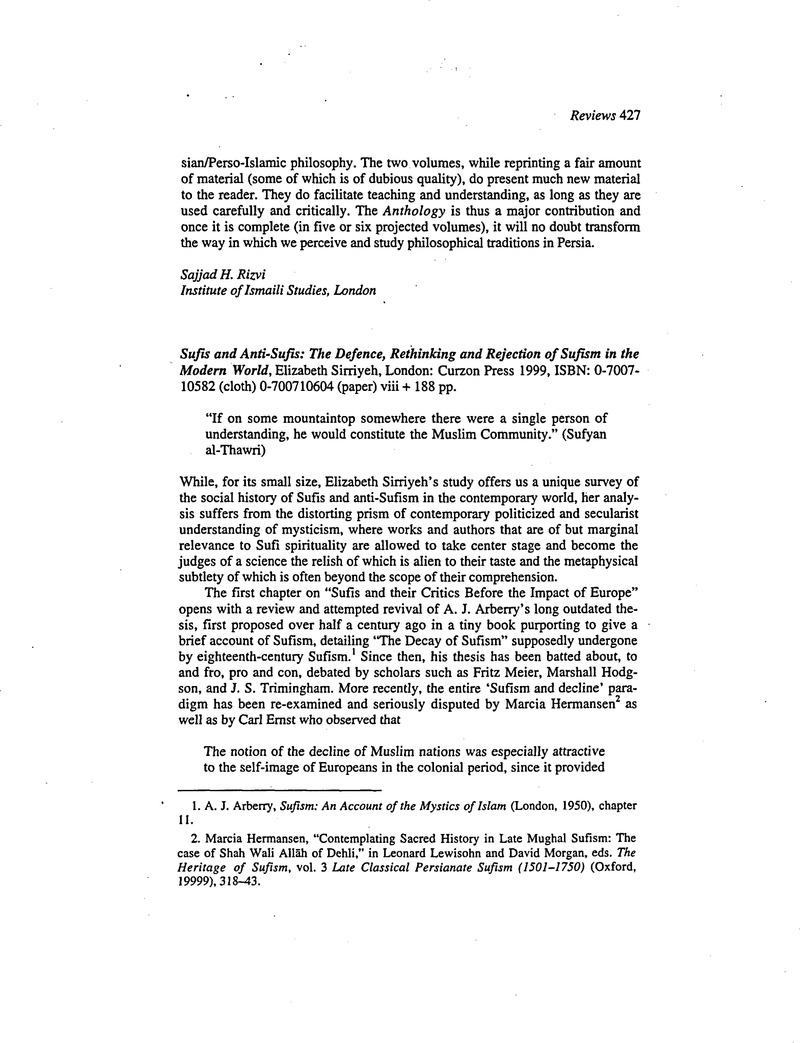No CrossRef data available.
Article contents
Sufis and Anti-Sufis: The Defence, Rethinking and Rejection of Sufism in the Modern World, Elizabeth Sirriyeh, London: Curzon Press 1999, ISBN: 0–7007–10582 (cloth) 0–700710604 (paper) viii + 188 pp.
Published online by Cambridge University Press: 01 January 2022
Abstract

- Type
- Reviews
- Information
- Copyright
- Copyright © Association For Iranian Studies, Inc 2000
References
1. Arberry, A. J., Sufism: An Account of the Mystics of Islam (London, 1950)Google Scholar, chapter 11.
2. Hermansen, Marcia, “Contemplating Sacred History in Late Mughal Sufism: The case of Shah Wali Allāh of Dehli,” in Lewisohn, Leonard and Morgan, David, eds. The Heritage of Sufism, vol. 3 Late Classical Persianate Sufism (1501-1750) (Oxford, 19999), 318–43Google Scholar.
3. Ernst, Carl, “Chishtī Meditation Practices of the Later Mughal Period,” in Lewisohn, and Morgan, the Heritage of Sufism 3: 346Google Scholar.
4. Ernst, Carl, The Shambhala Guide to Sufism (Boston, 1997), 24–25Google Scholar.
5. See Ghazali's, Al-Munqidh min al-ḍalāl, ed. Jabre, Farid (Beirut, 1969), 35–36Google Scholar where he situates Sufism as the supreme science in Islam. Marshall G. S. Hodgson points out that it was men such as Ghazali who helped make Sufism “acceptable to the ˒ulamā themselves,” so that “gradually Ṣūfism, from being one form of piety among others, and by no means the most acceptable one either officially or popularly, came to dominate religious life not only within the Jamaᶜi-Sunni fold, but to a lesser extent even among Shiᶜis.” The Venture of Islam: The Expansion of Islam in the Middle Periods 3 vols. (Chicago, 1977), 2: 203Google Scholar.
6. In the Bulletin of the British Society of Middle Eastern Studies 27 (2000): 216–20Google Scholar.
7. Dhahabi, Muhammad b. Ahmad, Siyar aᶜlam al-nubalā˒ (Beirut, 1981-85), 475Google Scholar, cited by Damghani, A. M., “Persian Contributions to Sufi Literature in Arabic,” in Lewisohn, L., ed., The Heritage of Sufism vol. 1Google Scholar Classical Persian Sufism from its Origins to Rumi, 47.
8. Brought out in my review in African Studies 90/360 (1991): 476-78 of R. S. O'Fahey, Enigmatic Saint: Ahmad ibn Idris and the Idrisi Tradition.
9. Thus Ibn Idris tolerantly states that “fanatical devotion to one's own school, the formation of factions, and accusing each other of heresy, as if it were a matter of different religions … such things we disapprove of.” Cited in my review of O'Fahey where Ibn Idris's anti-fundamentalism is highlighted.
10. “From the books of Sufism available in our land,” the man replied, “we have deduced that the sect of the Sufis are the most pious and peaceful of all Muslims. Since we consider a ‘perfect human being’ to be someone from whose hand and tongue all others are safe and secure, who does not annoy and irritate others, nor destroy their peace and contentment by botheration and torment, the main Muslim sect characterized by such ethics are the dervishes and their followers, for this group are seekers of wisdom and gnosis, who choose to reside in solitude and seclusion and refrain from association with folk of vain disposition.” Shirvani, Bustān al-siyāḥa (Tehran, 1315/1936), 31Google Scholar.
11. Churchill, Charles Henry, The Life of Abdel Kader (London: Chapman and Hall, 1897), 323Google Scholar, cited by Shah-Kazemi, Reza, “From Sufism to Terrorism: the Distortion of Islam in the Political Culture of Algeria,” in Shah-Kazemi, Reza, ed., Algeria: Revolution Revisited (London: Islamic World Report, 1997), 165Google Scholar.
12. Chodkiewicz, Michael, The Spiritual Writings of ‘Abd al-Kader (Albany, SUNY Press, 1995)Google Scholar.
13. Jami, Masṉawī-yi Haft Awrang, ed. Jabalqa ᶜAlishah, Janfada, Asghar, Ahrari, Tahir, and Tarbiyat, Husayn Ahmad (Tehran: Nashriyat-i Mira![]() -i Maktub, 1378/1999), 1:242–43Google Scholar.
-i Maktub, 1378/1999), 1:242–43Google Scholar.
14. Kashf al-mahjūb, ed. V. A. Zhukovskii (St. Petersburg, 1899 reprinted Leningrad, 1926), 51.
15. Kashf al-mahjūb, 47.
16. See “The Term Sufi as a Prescriptive Ethical Concept,” in Carl Ernst, The Shambhala Guide to Sufism, 18-26.
17. As I pointed out in a recent article that examines the conflict between mullas and Sufis in the context of early modern and contemporary Iran (1750-2000), most of the ṭarīqas in Iran still live in constant terror of the faqīhs’ Holy Inquisition. See Lewisohn, Leonard, “An Introduction into the History of Modern Persian Sufism,” Bulletin of the School of Oriental and African Studies, 61 (1998): 437–64CrossRefGoogle Scholar; 62 (1999): 36-59.
18. See Nasr, S. H., “ᶜIrfān-i naẓarī va sayr u sulūk dar taṣawwuf,” Iran-nāmah, 11 (1993): 121–27Google Scholar.




